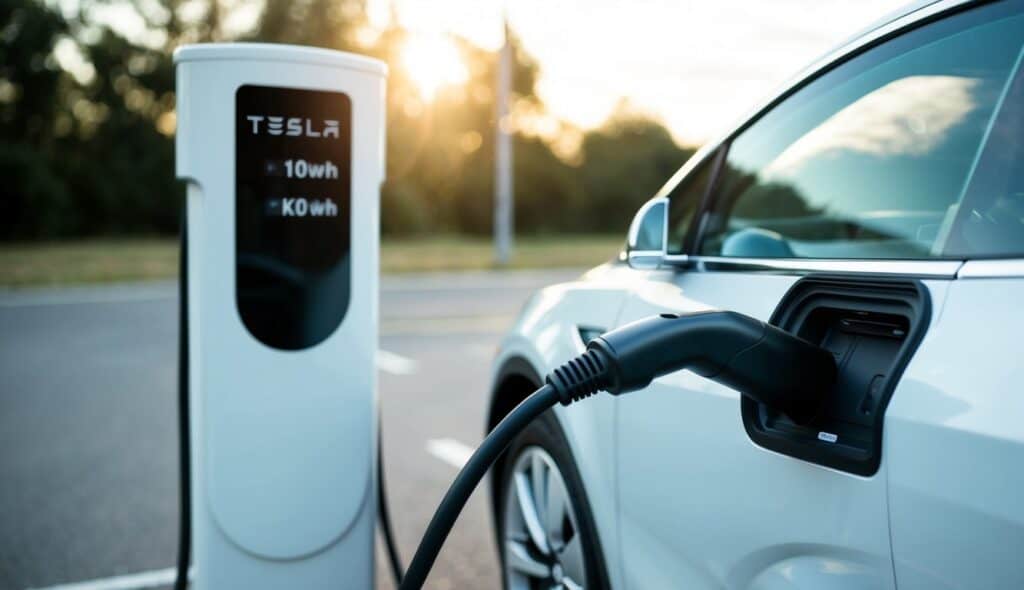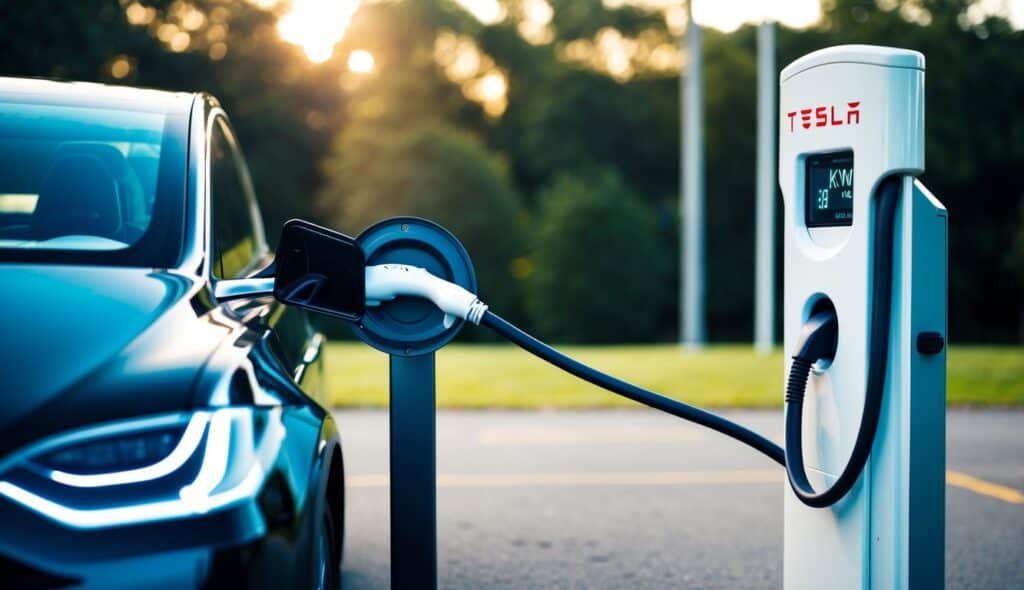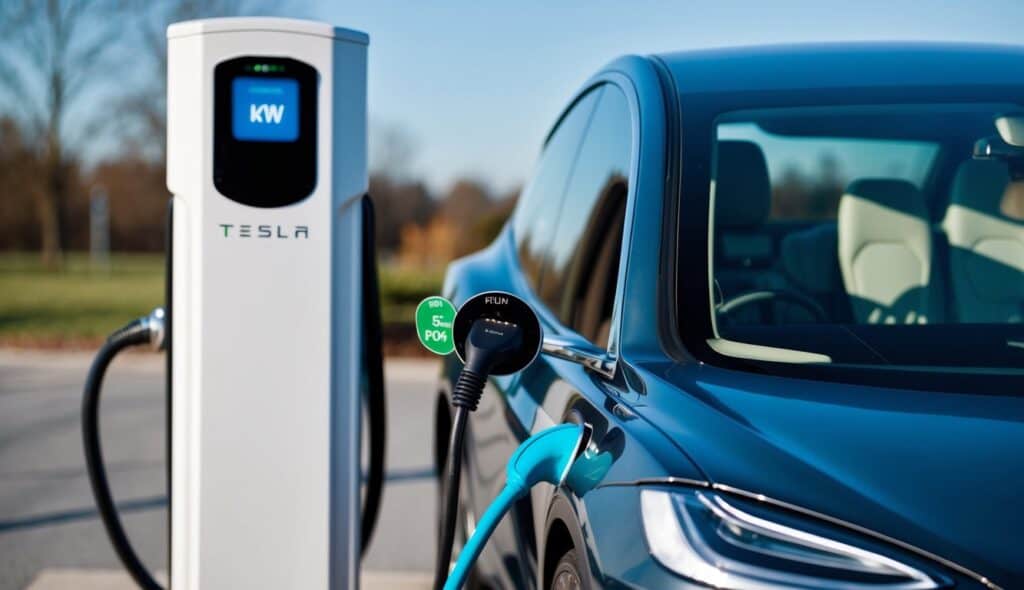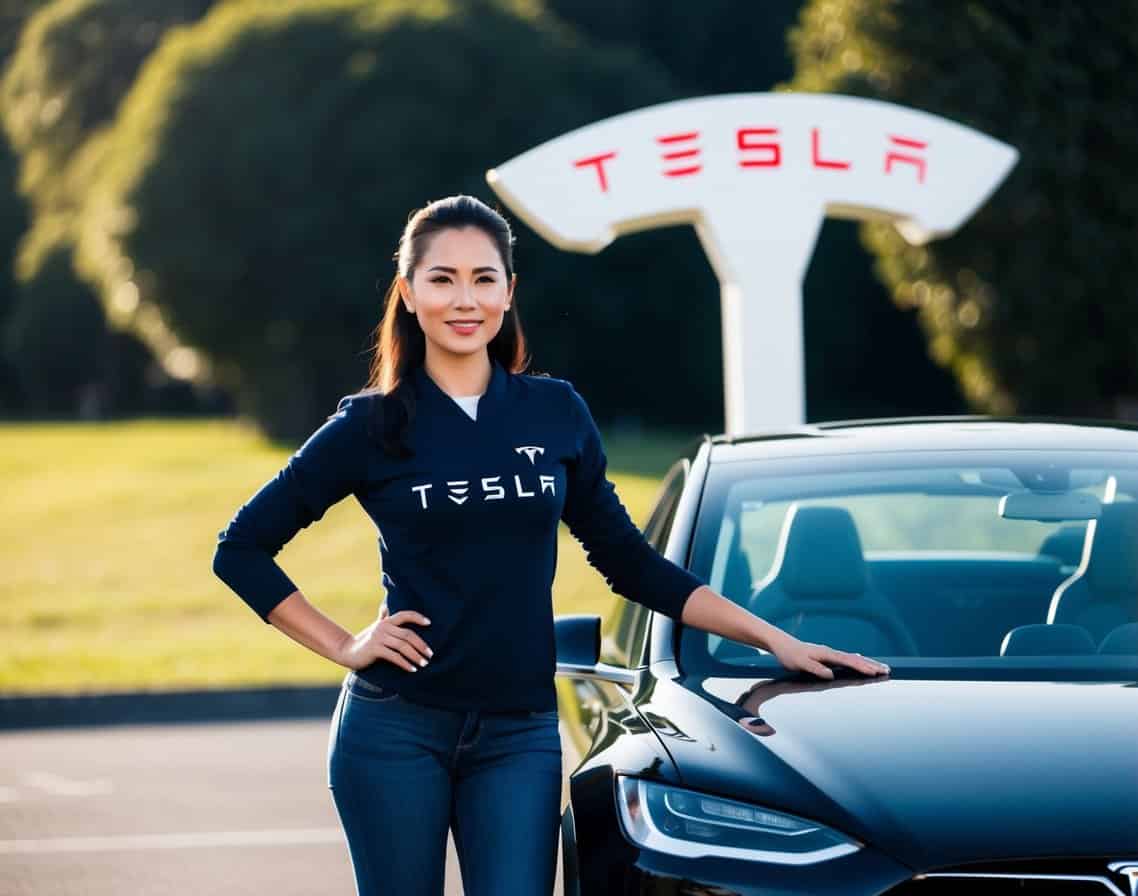Tesla has revolutionized electric vehicles with its cutting-edge technology and sleek designs. Many people wonder about the energy needed to charge these innovative cars. On average, it takes about 50-100 kWh to fully charge a Tesla, depending on the model and battery size.
The amount of energy required varies based on the specific Tesla model. The Model 3 Standard Range needs around 50-60 kWh for a full charge, while larger models like the Model S or Model X may use up to 100 kWh. This energy consumption translates to different charging times and costs for Tesla owners.
Charging a Tesla at home typically costs less than filling up a gas tank. With the U.S. average electricity rate of $0.13 per kWh, a full charge might cost between $6.50 to $13.00. This makes Tesla ownership environmentally friendly and cost-effective for many drivers.
Understanding Tesla Charging Basics
Tesla charging depends on battery size and the amount of power used. The amount of energy needed varies by model and setting.
Battery Capacity and Size
Tesla cars have different battery sizes. The Model 3 has a 60 kWh battery, but only 57.5 kWh is usable. The Model S and X can have batteries up to 100 kWh. Bigger batteries take more energy to charge fully.
Battery size affects range. A 60 kWh battery might go 250 miles, while a 100 kWh battery could reach 400 miles. Charging a bigger battery takes longer and uses more electricity.

Charging Percentage and Practice
Most Tesla owners don’t charge to 100% daily. Tesla recommends keeping the battery between 20% and 80% for everyday use. This helps the battery last longer.
Charging from 20% to 80% uses less energy than a full charge. For a 60 kWh battery, this is about 36 kWh. For longer trips, owners might charge to 100%.
Charging speed slows as the battery fills up. The last 20% takes longer than the first 80%. This is why many stick to the 20-80% range for daily charging.
Check out Tesla Wall Charger Green Light Issue
Methods of Charging a Tesla
Tesla owners have several ways to charge their vehicles. These include charging at home, using public stations, and accessing Tesla’s own Supercharger network. Each method offers different speeds and convenience levels.
Home Charging Options
Tesla provides two main options for home charging. The first is the Tesla Wall Connector. This device can add up to 44 miles of range per hour of charging. It’s a powerful and efficient choice for overnight charging.
The second option is the Tesla Mobile Connector. This portable charger plugs into a standard wall outlet. It’s slower than the Wall Connector but works well for top-ups and emergencies.
Both home charging options let owners wake up to a fully charged car each morning. They’re ideal for daily use and don’t require trips to charging stations.
Public Charging Solutions
Public chargers are found in many places, including parking lots, shopping centers, and workplaces. They offer a variety of charging speeds.
Level 2 chargers are common in public spaces. They add about 25-30 miles of range per hour, making them good for charging while shopping or working.
Some public stations have DC fast chargers. These can add up to 200 miles of range in just 15 minutes, making them great for quick top-ups during long trips.
Public chargers work with most electric cars, not just Teslas, giving owners more options when away from home.
Tesla Supercharger Network
The Tesla Supercharger network is a fast-charging system built just for Tesla cars. It’s designed for long-distance travel and quick charging stops.
Superchargers can add up to 200 miles of range in 15 minutes, which is much faster than most public chargers. They’re placed along major routes to support road trips.
Tesla has thousands of Supercharger stations worldwide, many of which have multiple charging spots, which helps reduce wait times during busy periods.
Superchargers are easy to find using the Tesla app or car navigation system. They offer a seamless charging experience for Tesla owners on the go.
Estimating Energy and Charging Time
Charging times and energy usage vary across Tesla models. Factors like battery size, charging speed, and starting charge level affect how long it takes to power up a Tesla.
Charging Time for Different Tesla Models
The Tesla Model 3 charges fastest among Tesla vehicles. With a 250 kW Supercharger, it can gain up to 175 miles of range in 15 minutes. The Model S takes about 40 minutes to charge from 10% to 80% using a Supercharger.
For the Model Y, a full charge from empty takes around 10 hours with a home charger. The Cybertruck’s charging time is not yet confirmed, but it’s expected to be similar to other Tesla models.
Charging speeds slow down as the battery fills up. This helps protect the battery’s lifespan.
Calculating Electricity Usage
Tesla cars use different amounts of energy. The Model 3 Standard Range uses about 24 kWh per 100 miles. The Model S Long Range needs around 28 kWh for the same distance.
To figure out charging costs:
- Check your car’s energy use (kWh per 100 miles)
- Multiply by miles driven
- Divide by 100
- Multiply by your electricity rate
For example, if a Model Y uses 28 kWh per 100 miles and electricity costs $0.13 per kWh:
- 300 mile trip = (28 × 300 / 100) × $0.13 = $10.92
Remember, charging at home is usually cheaper than using public chargers.
Check out Best Practices for Electric Vehicle Charging Infrastructure
Charging Technology Explained
Tesla vehicles use different charging technologies to replenish their batteries. These methods vary in speed and power delivery, affecting how quickly you can charge your car.
AC vs. DC Fast Charging
AC charging uses alternating current from the power grid. It’s slower but more common for home charging. DC fast charging uses direct current and offers much faster charging speeds.
AC charging requires the car to convert AC power to DC. This process happens inside the vehicle’s onboard charger. DC fast charging skips this step, sending DC power straight to the battery.
Most public charging stations offer AC charging. DC fast chargers are less common but growing in number. They’re often found along highways for quick pit stops during long trips.
Level 1 AC Charging
Level 1 is the slowest charging method. It uses a standard 120-volt household outlet and adds about 3-5 miles of range per hour to a Tesla.
While slow, Level 1 charging is convenient. You can plug in anywhere with a regular outlet. It’s useful for overnight charging at home or when no other options are available.
Tesla owners often use Level 1 charging as a backup option. It’s not ideal for daily use if you drive long distances regularly.
Level 2 AC Charging
Level 2 charging uses a 240-volt outlet, like those for large appliances. It’s much faster than Level 1, adding about 25-35 miles of range per hour to a Tesla.
Most Tesla owners install a Level 2 charger at home. It’s also common at workplaces and public parking areas. This charging level balances speed and convenience for daily use.
Tesla’s Wall Connector is a popular Level 2 home charging solution. It can fully charge most Tesla models overnight, making it perfect for regular use.
Check out Electric Vehicle Charging Points Building Regulations
Maximizing Charging Efficiency
Charging a Tesla efficiently involves smart practices and understanding different charging options. These methods can help drivers maximize each charge while minimizing costs and time spent at charging stations.

Optimal Charging Practices
To maximize charging efficiency, Tesla owners should aim to keep their battery level between 20% and 80%. This range is best for battery health and charging speed. Charging slows down significantly above 80%, so it’s often better to stop charging at this point unless you need the extra range.
Use Tesla’s Trip Planner for long journeys. It maps out optimal charging stops based on your route and current battery level. This tool helps you avoid unnecessary charging and saves time.
Preconditioning the battery before charging can speed up the process. Tesla cars have a feature that warms up the battery as you approach a Supercharger, allowing for faster charging upon arrival.
Understanding Destination Charging
Destination charging is a great way to top up your Tesla while parked at hotels, restaurants, or other locations. These chargers are typically slower than Superchargers but can be very convenient.
Many Tesla drivers plug in overnight at hotels with destination chargers. This allows for a full charge by morning without the need to stop at a Supercharger.
Tesla’s in-car navigation system shows nearby destination chargers. Plan your trips around these locations to make the most of your stops. Some places offer free charging, which can save money on longer trips.
Always check the power output of destination chargers. They can vary from 3.7 kW to 22 kW, affecting charging times.
Read Tesla Says Ready To Charge But Not Charging
Alternatives and Third-Party Options
Tesla owners have options beyond home charging. Public stations and third-party equipment give drivers more flexibility for powering up their vehicles.
Public Charging Stations
Public charging stations are growing in number across the U.S. Many shopping centers, parking garages, and rest stops now offer EV charging. Some stations are free, while others charge fees.
Tesla Superchargers are the fastest option for Tesla vehicles. They can add up to 200 miles of range in just 15 minutes. But Tesla cars can also use other networks with an adapter.
Popular public networks include ChargePoint, EVgo, and Electrify America. These work with all EV brands. Charging speeds vary from slow Level 2 to fast DC charging.
Apps like PlugShare help find nearby stations. They show real-time availability and let users leave reviews.
Third-Party Chargers and Adapters
Several companies make Tesla-compatible home chargers. These often cost less than Tesla’s official Wall Connector. Popular brands include JuiceBox, ChargePoint, and Grizzl-E.
Third-party chargers may offer features like Wi-Fi connectivity or power sharing. But they might charge slower than Tesla’s own products.
Adapters let Tesla cars use non-Tesla charging stations. The most useful is the J1772 adapter, which comes with every Tesla. It works with most public Level 2 chargers.
CCS adapters allow Teslas to use many DC fast chargers. Tesla now includes these with new cars in North America. Older models may need to buy one separately.
CHAdeMO adapters are also available—these work with some older DC fast charging stations, mostly in Asia.
Read How Many Miles Can a Tesla Go on One Charge?
Infrastructure and Future Developments
Tesla and other companies are rapidly expanding charging networks worldwide. New technologies aim to make EV charging faster and more convenient.

Global Charging Infrastructure
Tesla’s Supercharger network grew significantly in early 2024. They added 297 new stations, a 10% increase from the previous year. The average Supercharger station now has 9 charging ports. This expansion helps reduce wait times and improve access for Tesla drivers.
Other companies are also building out charging networks. By April 2024, the UK had over 61,000 public EV charging points, a 53% increase in a short time. The UK charging sector is expected to be worth £3.9 billion by 2030.
More chargers are being installed at homes, workplaces, and public spaces. This growth supports the rising number of EVs on roads globally.
Innovations in EV Charging
New charging tech focuses on speed and ease of use. Tesla is upgrading many Superchargers to 300 kW power output. This allows for much faster charging times.
Some companies are working on wireless charging pads. These would let EVs charge without plugging in. Another area of research is battery swapping. This could replace a drained battery with a fully charged one in minutes.
Smart charging systems are becoming more common. They can adjust charging times based on electricity rates and grid demand, helping lower costs and reduce strain on power grids during peak hours.
Tesla Charging Costs and Economy
Charging a Tesla involves different costs depending on the method used. The car’s trip planner helps drivers find the most efficient routes and charging stops.
Cost Analysis of Charging a Tesla
The cost to charge a Tesla varies based on electricity rates and charging location. Home charging is often cheaper than public stations. On average, it costs about $0.044 per mile to charge a Tesla.
For a 100-mile trip, the charging cost is around $4.42. This is based on the national average electricity price of $0.13 per kWh. A full charge for a Tesla Model 3 with a 75 kWh battery costs about $9.75 at home.
Public charging stations, like Tesla Superchargers, are more expensive. They can cost twice as much as home charging. Prices at Superchargers start at $0.25 per kWh.
Understanding Tesla’s Trip Planner
Tesla’s Trip Planner is a helpful tool for long drives. It maps out the best route and shows where to stop for charging. The planner takes into account:
- Battery level
- Charging station locations
- Expected energy use
This feature helps reduce “range anxiety” for drivers. It shows how long each charging stop will take. The planner also adjusts for real-time factors like traffic and weather.
Tesla cars can navigate directly to these planned charging stops, making long trips in an electric vehicle much easier to manage.
Comparative Models Analysis
Tesla offers various models with different battery capacities and charging capabilities. The Model Y Long Range and Model S Plaid stand out for their impressive range and charging speeds.
Tesla Model Y Long Range
The Model Y Long Range has a 75 kWh battery pack. It can travel up to 330 miles on a single charge. At a Supercharger, this model can add up to 162 miles of range in just 15 minutes.
A Level 2 charger can fully charge the Model Y Long Range in about 11-12 hours for home charging. This is ideal for overnight charging.
The Model Y Long Range supports peak charging rates of up to 250 kW at V3 Superchargers, allowing for quick top-ups during long trips.
Tesla Model S Plaid Capabilities
The Model S Plaid boasts a larger 100 kWh battery pack. It provides an EPA-estimated range of 396 miles and can charge even faster than the Model Y.
At a V3 Supercharger, the Model S Plaid can reach peak charging rates of 250 kW. It can add up to 200 miles of range in just 15 minutes.
Home charging with a Level 2 charger takes around 14-15 hours for a full charge. The Plaid’s larger battery capacity means it requires more time to charge completely.
The Model S Plaid’s charging curve maintains high speeds for longer, resulting in shorter overall charging times during road trips.
How Many kWh to Charge a Tesla Model Y
The amount of kWh needed to charge a Tesla Model Y depends on its specific variant and battery capacity.
For the Standard Range Model Y, it takes about 60-65 kWh to charge the battery fully. This provides around 244 miles of range.
The Long Range Model Y has a larger battery pack requiring approximately 75-80 kWh for a full charge. This allows for up to 330 miles of driving range.
The Performance Model Y also uses a 75-80 kWh battery but delivers slightly less range at 303 miles due to its higher power output.
On average, a Model Y uses between 0.24-0.30 kWh per mile driven. The exact efficiency varies based on driving conditions and style.
To calculate annual charging needs:
- Estimate yearly mileage (e.g. 14,000 miles)
- Multiply by average efficiency (0.26 kWh/mile)
- Add 10% for charging losses
Example calculation: 14,000 miles x 0.26 kWh/mile = 3,640 kWh 3,640 kWh + 10% = 4,004 kWh per year
This gives a rough estimate of total kWh needed annually to charge a Tesla Model Y under typical usage.
How Many kWh to Charge a Tesla Model 3
The Tesla Model 3 comes in different versions with varying battery capacities. The 2023 Standard Range Model 3 (RWD) has a 57.5 kWh usable battery capacity. The 2023 Long Range Model 3 can hold up to 82 kWh.
To fully charge a Standard Range Model 3 from empty, it would require about 57.5 kWh of electricity. For the Long Range version, it would need around 82 kWh.
Charging isn’t 100% efficient, though. Some energy is lost in the process. Tesla chargers typically have about 90% efficiency.
This means to charge a Standard Range Model 3 fully, you’d actually use:
- 57.5 kWh ÷ 0.90 = 63.9 kWh
For a Long Range Model 3:
- 82 kWh ÷ 0.90 = 91.1 kWh
The exact amount can vary based on factors like:
- Battery temperature
- Charging speed
- Current battery level
It’s worth noting that most Tesla owners don’t regularly charge from 0% to 100%. Partial charges are more common and use less electricity.
How Many kWh to Charge a Tesla Model X
The Tesla Model X comes in different battery configurations. The amount of kWh needed to charge it depends on the specific model and battery size.
For the Model X Long Range, which has a 100 kWh battery pack, a full charge from 0% to 100% would require approximately 100 kWh of electricity.
The Model X Plaid also has a 100 kWh battery, so it would need the same amount to charge fully.
Charging efficiency is about 94%, meaning some energy is lost in the process. To fully charge a 100 kWh battery, you may actually use around 106 kWh from your power source.
It’s important to note that most drivers don’t regularly charge from 0% to 100%. Tesla recommends keeping the battery between 20% and 80% for daily use.
Charging from 20% to 80% on a 100 kWh battery would use about 60 kWh of electricity.
The exact amount of energy needed can vary based on factors like:
- Charging speed
- Temperature
- Battery condition
- Charging equipment efficiency
These factors can slightly increase or decrease the total kWh required for a full charge.
How Many kWh to Charge a Tesla Model S
The Tesla Model S has a large battery capacity that varies depending on the specific version. Most Model S variants have batteries ranging from 75 kWh to 100 kWh.
To fully charge a 100 kWh Model S battery from empty would require approximately 100 kWh of electricity. However, charging is not 100% efficient.
Typical charging efficiency for electric vehicles is around 90-94%. This means some energy is lost as heat during the charging process.
Considering efficiency, charging a 100 kWh Model S battery from 0% to 100% would use about 106-111 kWh of electricity from the power source.
Notably, most Tesla owners don’t regularly charge from 0% to 100%. Daily charging to 80-90% is more common for battery longevity.
Charging costs vary based on electricity rates. At $0.15 per kWh, a full charge would cost:
- 75 kWh battery: $11.25 – $12.50
- 100 kWh battery: $15.00 – $16.65
These estimates may differ slightly based on factors like charging speed, temperature, and battery condition.
Conclusion
The amount of kWh needed to charge a Tesla varies based on the model and battery size. Most Tesla vehicles require between 50-100 kWh for a full charge.
Charging efficiency impacts the total energy used. About 90-94% of the electricity drawn from the grid ends up stored in the battery.
Costs depend on local electricity rates. At the U.S. average of $0.13/kWh, charging a Tesla typically costs $4-8 per 100 miles of range.
Tesla’s online calculator helps owners estimate charging times and costs for their specific vehicle and situation.
Factors like charging speed, battery temperature, and current charge level affect the exact kWh needed for each charging session.
Understanding a Tesla’s energy usage allows owners to plan trips better and manage charging costs. With careful charging practices, Teslas can operate very economically.

Hi, I’m Marybeth, an electric car enthusiast living in New York in the USA. As the owner of electriccartalks.com, I love sharing my knowledge on EV tips, battery maintenance, and charging solutions. As a proud Tesla owner, I blend my personal experiences with professional insights to offer valuable information to fellow EV enthusiasts. Through my articles, I aim to empower others to make informed decisions about their electric vehicles. Read more